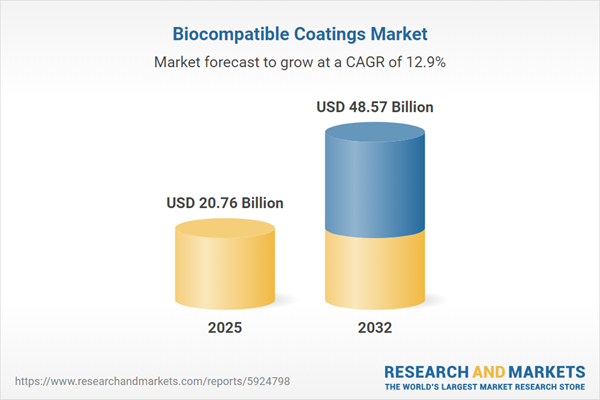Speak directly to the analyst to clarify any post sales queries you may have.
The biocompatible coatings market is undergoing rapid evolution as new materials and engineering approaches connect advanced device functions with demanding healthcare standards. Senior decision-makers must navigate complex regulatory, sourcing, and technology dynamics as they evaluate opportunities in this high-growth sector.
Market Snapshot: Biocompatible Coatings Market Size and Momentum
Biocompatible coatings serve as a critical bridge between medical devices and patient safety. The market is demonstrating strong expansion, lifted by innovation in surface science and greater regulatory alignment worldwide. This growth reflects mounting demand for coatings that offer not only protection and durability but also improved interactions at the biological interface. Advancements are accelerating across established manufacturers and emerging players, as next-generation materials are commercialized with an emphasis on efficiency and resilience.
Scope & Segmentation: In-Depth Analysis Across Materials, Applications, Users, and Technology
- Material Types:
- Ceramic coatings for advanced wear resistance
- Composite coatings that leverage nanoparticles with polymers
- Metallic coatings such as titanium nitride and diamond-like carbon for high mechanical strength
- Polymer coatings including hydrogel, parylene, polyethylene glycol, and silicone for customized biocompatibility and function
- Applications:
- Diagnostic equipment requiring transparency and anti-fouling
- Drug delivery systems using microencapsulation, nano carriers, and stent coatings for controlled release and targeted functionality
- Implantable devices covering cardiovascular, dental, ophthalmic, and orthopedic uses
- Surgical instruments where antimicrobial surfaces reduce infection risk
- Tissue engineering scaffolds aiding cell growth and matrix development
- End User Industries:
- Contract research organizations focusing on reproducibility
- Hospitals and clinics seeking streamlined sterilization and reduced revisions
- Medical device manufacturers driving miniaturization and device integration
- Pharmaceutical companies advancing coated drug delivery implants
- Research laboratories specializing in formulation innovation
- Technologies:
- Chemical vapor deposition in low pressure, metal-organic, and plasma-enhanced variants
- Electrospinning approaches such as blend, coaxial, and melt techniques for nanofiber formation
- Physical vapor deposition by electron beam, sputtering, or thermal evaporation for optimal adhesion
- Plasma spraying in atmospheric or vacuum settings for robust layers
- Sol-gel methods featuring dip, spin, or spray coating of ceramic and hybrid films
- Regional Coverage:
- Americas: United States, Canada, Mexico, Brazil, Argentina, Chile, Colombia, Peru
- Europe, Middle East & Africa: United Kingdom, Germany, France, Russia, Italy, Spain, Netherlands, Sweden, Poland, Switzerland, United Arab Emirates, Saudi Arabia, Qatar, Turkey, Israel, South Africa, Nigeria, Egypt, Kenya
- Asia-Pacific: China, India, Japan, Australia, South Korea, Indonesia, Thailand, Malaysia, Singapore, Taiwan
- Key Companies:
- Surmodics, Inc.
- DuPont de Nemours, Inc.
- DSM Biomedical B.V.
- Evonik Industries AG
- Akzo Nobel N.V.
- Henkel AG & Co. KGaA
- 3M Company
- Merck KGaA
- Specialty Coating Systems, Inc.
- Covalon Technologies Ltd.
Key Takeaways for Strategic Decision-Making
- Advanced coatings enable multifunctional medical devices, combining protective and therapeutic attributes essential for next-generation treatments.
- Regulatory harmonization is propelling faster market approval and broader adoption for emerging coatings, with a focus on measurable patient outcomes.
- Collaborative development between research institutions and industry accelerates material innovation while supporting compliance and performance objectives.
- Diversified sourcing strategies and local investment are increasing resilience against global supply chain disruptions and tariff changes.
- Precision biointegration trends are driving customization at the anatomical level, supporting device longevity and reducing the risk of complications.
- Rising investment in pilot production and quality control supports scalable adoption of newly formulated coatings.
Tariff Impact on Sourcing and Production
Recent U.S. tariff shifts have added complexity for coating manufacturers sourcing raw materials internationally. In response, organizations are prioritizing supplier diversification, negotiating cost-sharing with partners, and investing in local capabilities. This strategy has improved supply chain stability and limited cost unpredictability, positioning proactive firms to navigate regulatory and logistical changes with greater agility.
Methodology & Data Sources
The report draws on primary interviews with coating experts, device executives, and regulatory authorities alongside systematic secondary research of peer-reviewed journals, patents, and standardization documents. Insights were subject to data triangulation and peer review to ensure accuracy and actionable clarity.
Why This Report Matters
- Pinpoints commercial opportunities across evolving biocompatible coatings supply chains and application segments.
- Guides regulatory alignment and sourcing decisions for sustainable growth and compliance.
- Supports investment prioritization in material innovation, collaboration, and regional production diversity.
Conclusion
As biocompatible coatings become central to advanced medical device design, leaders must align innovation with regulatory rigor and supply chain resilience. This report empowers stakeholders to capitalize on market shifts and drive effective strategies for long-term success.
Additional Product Information:
- Purchase of this report includes 1 year online access with quarterly updates.
- This report can be updated on request. Please contact our Customer Experience team using the Ask a Question widget on our website.
Table of Contents
3. Executive Summary
4. Market Overview
7. Cumulative Impact of Artificial Intelligence 2025
Companies Mentioned
The companies profiled in this Biocompatible Coatings market report include:- Surmodics, Inc.
- DuPont de Nemours, Inc.
- DSM Biomedical B.V.
- Evonik Industries AG
- Akzo Nobel N.V.
- Henkel AG & Co. KGaA
- 3M Company
- Merck KGaA
- Specialty Coating Systems, Inc.
- Covalon Technologies Ltd.
Table Information
| Report Attribute | Details |
|---|---|
| No. of Pages | 197 |
| Published | October 2025 |
| Forecast Period | 2025 - 2032 |
| Estimated Market Value ( USD | $ 20.76 Billion |
| Forecasted Market Value ( USD | $ 48.57 Billion |
| Compound Annual Growth Rate | 12.8% |
| Regions Covered | Global |
| No. of Companies Mentioned | 11 |









